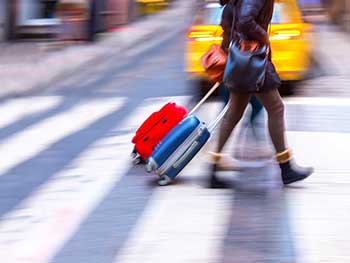
Crosswalks can give us an inflated sense of security because we believe that cars will automatically stop when we are standing in one. In many locations, the law says that cars are supposed to stop for persons in a crosswalk. In marked crosswalks in Maryland, that is the law. But other situations exist where vehicles in our state have the right of way.
Maryland Pedestrians in Danger
The year 2016 saw eight pedestrian deaths in Montgomery County and 16 in Prince George’s County. From 2005 through 2014, our state reported 1,053 pedestrian deaths. Nationally, the Governors Highway Safety Association stated that the first half of 2016 registered an estimated 11 percent increase in pedestrian fatalities over 2015.
Maryland is ranked 15th in the U.S. when it comes to pedestrian dangers. Among the U.S. metro areas, Baltimore was listed as the 55th most dangerous city for pedestrians, while nearby Washington, D.C., was 49th.
Crosswalk Laws in Maryland
A pedestrian’s right of way in Maryland crosswalks is partially addressed in state law section 21-502; the section does not cover situations where a traffic control signal is operating or where a tunnel or overhead crossing is in place.
What 21-502 does address is when a vehicle must stop for a pedestrian in a crosswalk. If a pedestrian is approaching or standing in a crosswalk on the same road where a vehicle is traveling, the vehicle is expected to stop because the pedestrian has the right of way. However, even though the pedestrian has the right of way, they are expected to exercise common sense and not step directly in front of traffic that cannot be reasonably expected to stop in time. Additionally, a vehicle is not permitted to pass another vehicle that is stopped for a pedestrian in a crosswalk.
Section 21-503 addresses crossing a street at other than marked crosswalks (those areas without painted lines or other markings indicating a crossing area). Generally, a pedestrian must yield the right of way if they are crossing at an unmarked area that is not an intersection with traffic controls.
Of course, even a marked crosswalk is no guarantee of safety. During March, 2017, a 49-year-old man was struck and killed crossing at a marked crosswalk in Silver Spring. The driver, who was later arrested under suspicion of DUI, left the scene, making the accident a hit and run.
A Big Contributing Factor
One of the biggest reasons for pedestrian accidents is the right-turn-on-red laws, which allow a motorist to turn right on a red light after coming to a full stop. All too often, drivers roll into the crosswalk area, impatient to be on their way, sometimes not even stopping, and certainly not looking out for pedestrians. Research in Minnesota demonstrated that more than one-third of crashes in that state involving pedestrians and vehicles resulted from a driver’s failure to yield the right of way. Crash data from 2007 through 2011 indicated that nearly 300 persons per year suffered injuries because of driver error in Minnesota. Some cities like Seattle are now banning right turn on red at certain intersections because of pedestrian injury.
On the occasions when you are a pedestrian, we urge you not to rely upon the fact that you have the right of way. Be defensive when it comes to crossing the road, even with traffic signals and marked crosswalks. However, should you suffer an injury as a pedestrian through no fault of your own, know that the law in Maryland is on your side. For that reason, you might consider seeking legal advice in such a situation.
We’re listening. How can we help?
At the Law Offices of Steven H. Heisler, we have devoted our practice to defending the rights of personal injury victims. We know how traumatic a serious car accident can be for both the injured person and for his or her family. If you or a loved one was seriously injured, whether in a vehicle or as a pedestrian, you may be entitled to various kinds of financial compensation, such as medical bills, lost wages, and pain and suffering. Keep in mind, however, that there is a statute of limitations – or a time limit – for filing personal injury claims. If you have been injured in an accident, you should not delay. Contact Steve today for a free initial consultation by calling (410) 625-4878 or use our online form.
